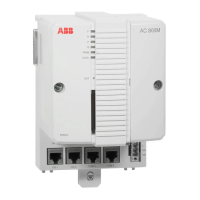PM891/PM86x/TP830 Processor Unit – Redundancy Section 1 Introduction
48 3BSE036351-510 A
PM891 Redundancy
The Redundancy Link in PM891 consists of two physical links. These are the
RCU Data Link and the RCU Control Link.
The RCU Data Link is a fast communication channel used to transfer the data
required to keep the backup CPU synchronized with the primary CPU.
TK855 RCU Data Link Cable is used for the data link.
The RCU Control Link is used for role selection and CPU identity assignment
(UPPER/LOWER).
TK856 RCU Control Link Cable is used for the control link.
Fault Tolerance Principle
The principle of fault tolerance in the redundant processor units is based on
continuous updating of the backup unit to the same status as the primary unit. This
enables the backup unit to assume control without affecting surrounding systems in
a bumpless manner.
This principle involves dynamic division of the program execution into execution
units and the creation of rollback points at which the processor unit's status is
completely defined.
In this context, the processor unit's total status is defined as the processor unit's
internal status, that is, the contents of the processor registers, plus the contents of the
data memory.
The backup unit's status is updated each time the primary unit passes a rollback
point, enabling the backup unit to resume program execution from the last rollback
point passed, should the primary unit fail due to error.
In order to minimize the amount of information involved in the update, the backup
unit is updated only with the changes taking place since the latest rollback point.
Between rollback points, these changes that writes in the data memory, are stored in
a log buffer in the backup unit. At a rollback point, the processor's total register
contents are also written into the data memory, so that this information is also
logged. Once the rollback point is established, the logged write operations are
transferred to the backup unit's data memory.

